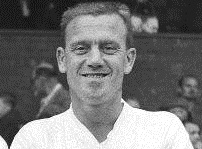|
|
|
Jimmy
Langley |
Brighton & Hove
Albion FC, Fulham FC
3 appearances, 0 goals
P 3 W 2 D
0 L 1 F 6: A 6
67% successful
1955-58
captain: none
minutes played: 270 |
|
 |
|
Timeline |
| |
Ernest James Langley |
|
Birth |
7 February 1929
in Kilburn, Middlesex [registered in
Willesden, March 1929]. |
|
Marriage |
to June P.F. Edwards
[registered in Uxbridge, Middlesex, September 1950]. Three children |
|
Death |
9 December 2007 in West Drayton, Middlesex,
aged
78 years 305 days. |
|
Source |
 Douglas Lammings' An
English Football Internationalist Who's Who [1990] & Douglas Lammings' An
English Football Internationalist Who's Who [1990] & |
|
Club Career |
|
Club(s) |
Played schoolboy football in the London area before turning out
for a number of sides in his formative years, including Yiewsley FC,
Hounslow Town FC, Uxbridge FC, Hayes FC, at the same time he joined
Brentford FC on apprentice forms, Ruislip FC and then Guildford City FC in
1947. He turned professional in 1949. Signed for Leeds United FC in June
1952, played only nine league appearances, scoring three times
when Brighton & Hove Albion FC signed Langley for £1500 in July 1953.
After 178 league appearances, when he scored another sixteen
goals, he joined Fulham FC in February 1957 for £12,000,
another 356 league appearances followed, along with 33
goals. Queen's Park Rangers FC then signed Langley in June 1965
for £4,000, and another 87 league appearances and nine goals
followed. Hillingdon Borough FC took him as player/manager in
September 1967, a position held until May 1971. |
|
Club honours |
Inter-Cities Fairs Cup runners-up 1957-58;
Football League Cup winners 1966-67; Football League
Division Three winners 1966-67; |
|
Individual honours |
Football League (one appearance) |
|
Distinctions |
Langley Close exists on the site of Guildford City's
Joseph's Road ground, in Gentleman Jim's honour. |
|
Height/Weight |
5'
9", 11st.
5lbs [1958]. |
|
Source |
Douglas Lammings' An English
Football Internationalist Who's Who [1990]. |
|
Management Career |
|
Club(s) |
After leaving Hillingdon in May 1971, Langley became coach at
Crystal Palace. He returned to Hillingdon Borough FC as manager in 1973.
He returned to the hotseat with Dulwich Hamlet FC in 1976-77; |
|
Club honours |
FA Trophy runners-up 1970-71; |
|
England Career |
|
Player number |
766th
player to appear for England. |
|
Position(s) |
Left-back |
|
First match |
No. 318, 19 April 1958,
Scotland 0 England 4, a British Championship match at Hampden Park,
Mount Florida, Glasgow, aged 29 years 71 days. |
|
Last match |
No. 320, 11 May 1958, Yugoslavia 5 England 0, an end-of-season tour match at Stadion Jugoslovenska Narodna Armija, Beograd, aged 29 years 93 days. |
|
Major tournaments |
World Cup Finals 1958 (provisional) |
|
Team honours |
None |
|
Individual honours |
England B (three
appearances, 1955-56) |
|
Distinctions |
None |
|
Beyond England |
|
No information. -
An English Football Internationalists' Who's Who.
Douglas Lamming (1990). Hatton Press, p.153. |
|
The Numbers |
|
parties |
Appearances |
comp. apps |
reserve |
minutes |

|
 |
captain |
|
7 |
3 |
1 |
three |
270 |
0 |
 1
1 |
none |
|
minutes are an approximation, due to the fact that many matches rarely stick to exactly ninety minutes long, allowing time for injuries and errors. |
|
P |
W |
D |
L |
F |
A |
GD |
FTS
|
CS |
FAv |
AAv |
Pts% |
W/L |
|
3 |
2 |
0 |
1 |
6 |
6 |
=0 |
1 |
1 |
2 |
2 |
66.7 |
+1 |
|
All matches were played in a white shirt |
Venue Record
|
Venue |
P |
W |
D |
L |
F |
A |
GD |
FTS
|
CS |
FAv |
AAv |
Pts% |
W/L |
|
Home |
1 |
1 |
0 |
0 |
2 |
1 |
+1 |
0 |
0 |
2.00 |
1.00 |
100.0 |
+1 |
|
Away |
2 |
1 |
0 |
1 |
4 |
5 |
-1 |
1 |
1 |
2.00 |
2.50 |
50.0 |
=0 |
Competition Record
|
Competition |
P |
W |
D |
L |
F |
A |
GD |
FTS |
CS |
FAv |
AAv |
Pts% |
W/L |
|
British Championship |
1 |
1 |
0 |
0 |
4 |
0 |
+4 |
0 |
1 |
4.00 |
0.00 |
100.0 |
+1 |
| Friendly |
2 |
1 |
0 |
1 |
2 |
6 |
-4 |
1 |
0 |
1.00 |
2.00 |
50.0 |
=0 |
Tournament Record
|
British Championship Competition |
|
Type |
P |
W |
D |
L |
F |
A |
GD |
FTS |
CS |
FAv |
AAv |
Pts% |
W/L |
|
BC 1957-58 |
1 |
1 |
0 |
0 |
4 |
0 |
+4 |
0 |
1 |
4.00 |
0.00 |
100.0 |
+1 |
|
All |
1 |
1 |
0 |
0 |
4 |
0 |
+4 |
0 |
1 |
4.00 |
0.00 |
100.0 |
+1 |
|
All Competition |
|
Type |
P |
W |
D |
L |
F |
A |
GD |
FTS |
CS |
FAv |
AAv |
Pts% |
W/L |
|
BC |
1 |
1 |
0 |
0 |
4 |
0 |
+4 |
0 |
1 |
4.00 |
0.00 |
100.0 |
+1 |
|
1 |
1 |
0 |
0 |
4 |
0 |
+4 |
0 |
1 |
4.00 |
0.00 |
100.0 |
+1 |
Match History
|
apps |
match |
pic |
match details |
comp |
res. |
rundown |
shirt |
|
England's selectors announced their forty-man squad from whom the final
22 would be selected, on April 22 1958.
Of the 18 players who were cut from the squad on 28 May, they included
Jim Langley. |
|
|